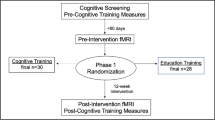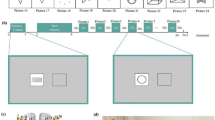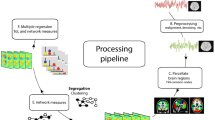Abstract
Speed-of-processing abilities decline with age yet are important in performing instrumental activities of daily living. The useful field of view, or Double Decision task, assesses speed-of-processing and divided attention. Performance on this task is related to attention, executive functioning, and visual processing abilities in older adults, and poorer performance predicts more motor vehicle accidents in the elderly. Cognitive training in this task reduces risk of dementia. Structural and functional neural correlates of this task suggest that higher-order resting state networks may be associated with performance on the Double Decision task, although this has never been explored. This study aimed to assess the association of within-network connectivity of the default mode network, dorsal attention network, frontoparietal control network, and cingulo-opercular network with Double Decision task performance, and subcomponents of this task in a sample of 267 healthy older adults. Multiple linear regressions showed that connectivity of the cingulo-opercular network is associated with visual speed-of-processing and divided attention subcomponents of the Double Decision task. Cingulo-opercular network and frontoparietal control network connectivity is associated with Double Decision task performance. Stronger connectivity is related to better performance in all cases. These findings confirm the unique role of the cingulo-opercular network in visual attention and sustained divided attention. Frontoparietal control network connectivity, in addition to cingulo-opercular network connectivity, is related to Double Decision task performance, a task implicated in reduced dementia risk. Future research should explore the role these higher-order networks play in reduced dementia risk after cognitive intervention using the Double Decision task.

adapted from POSIT Brain HQ, used with permission. Panel A = Hawk Eye, panel B = Divided Attention, panel C = Double Decision


Similar content being viewed by others
Data and materials availability
The data analyzed in this study is subject to the following licenses/restrictions: data are managed under the data sharing agreement established with NIA and the parent R01 clinical trial Data Safety and Monitoring Board in the context of an ongoing Phase III clinical trial (ACT study, R01AG054077). All trial data will be made publicly available 2 years after completion of the parent clinical trial, per NIA and DSMB agreement. Requests for baseline data can be submitted to the ACT Publication and Presentation (P&P) Committee and will require submission of a data use, authorship, and analytic plan for review by the P&P committee (ajwoods@phhp.ufl.edu). Requests to access these datasets should be directed to ajwoods@ufl.edu.
Code availability
Not applicable.
References
Parkin AJ, Java RI. Deterioration of frontal lobe function in normal aging: influences of fluid intelligence versus perceptual speed. Neuropsychology. 1999;13:7.
Salthouse TA. Selective review of cognitive aging. J Int Neuropsychol Soc. 2010;16:754–60. https://doi.org/10.1017/S1355617710000706.
Verhaeghen P, Salthouse TA. Meta-analyses of age-cognition relations in adulthood: estimates of linear and nonlinear age effects and structural models. Psychol Bull. 1997;122:19.
Clay OJ, Edwards JD, Ross LA, Okonkwo O, Wadley VG, Roth DL, et al. Visual function and cognitive speed of processing mediate age-related decline in memory span and fluid intelligence. J Aging Health. 2009;21:547–66. https://doi.org/10.1177/0898264309333326.
Ebaid D, Crewther SG, MacCalman K, Brown A, Crewther DP. Cognitive processing speed across the lifespan: beyond the influence of motor speed. Front Aging Neurosci 2017;9. https://doi.org/10.3389/fnagi.2017.00062.
Reuter-Lorenz PA, Festini SB, Jantz TK. "Executive functions and neurocognitive aging." In Handbook of the psychology of aging, pp. 67-81. Academic Press, 2021.
Salthouse TA. Decomposing age correlations on neuropsychological and cognitive variables. J Int Neuropsychol Soc. 2009;15:650–61. https://doi.org/10.1017/S1355617709990385.
Cahn-Weiner DA, Boyle PA, Malloy PF. Tests of executive function predict instrumental activities of daily living in community-dwelling older individuals. Appl Neuropsychol. 2002;9:187–91. https://doi.org/10.1207/S15324826AN0903_8.
Johnson JK, Lui L-Y, Yaffe K. Executive function, more than global cognition, predicts functional decline and mortality in elderly women 2007:15.
Aust F, Edwards JD. Incremental validity of useful field of view subtests for the prediction of instrumental activities of daily living. J Clin Exp Neuropsychol. 2016;38:497–515. https://doi.org/10.1080/13803395.2015.1125453.
Ball KK. Clinical visual perimetry under-estimates peripheral field problems in older adults. Clin Vis Sci. 1990;5:113–25.
Woutersen K, Guadron L, van den Berg AV, Boonstra FN, Theelen T, Goossens J. A meta-analysis of perceptual and cognitive functions involved in useful-field-of-view test performance. J Vis. 2017;17:11. https://doi.org/10.1167/17.14.11.
Ball KK, Owsley C, Sloane ME, Roenker DL, Bruni JR. Visual attention problems as a predictor of vehicle crashes in older drivers. Invest Ophthalmol Vis Sci. 1993;34:3110–23.
Clay OJ, Wadley VG, Edwards JD, Roth DL, Roenker DL, Ball KK. cumulative meta-analysis of the relationship between useful field of view and driving performance in older adults: current and future implications. Optom Vis Sci. 2005;82:724–31. https://doi.org/10.1097/01.opx.0000175009.08626.65.
Ball K, Berch DB, Helmers KF, Jobe JB, Leveck MD, Marsiske M, et al. Effects of cognitive training interventions with older adults: a randomized controlled trial. JAMA. 2002;288:2271. https://doi.org/10.1001/jama.288.18.2271.
Rebok GW, Ball K, Guey LT, Jones RN, Kim H-Y, King JW, et al. Ten-year effects of the advanced cognitive training for independent and vital elderly cognitive training trial on cognition and everyday functioning in older adults. J Am Geriatr Soc. 2014;62:16–24. https://doi.org/10.1111/jgs.12607.
Edwards JD, Xu H, Clark DO, Guey LT, Ross LA, Unverzagt FW. Speed of processing training results in lower risk of dementia. Alzheimers Dement Transl Res Clin Interv. 2017;3:603–11. https://doi.org/10.1016/j.trci.2017.09.002.
Ross LA, Sprague BN, Phillips CB, O’Connor ML, Dodson JE. The impact of three cognitive training interventions on older adults’ physical functioning across 5 years. J Aging Health. 2018;30:475–98. https://doi.org/10.1177/0898264316682916.
Wolinsky FD, Mahncke HW, Kosinski M, Unverzagt FW, Smith DM, Jones RN, et al. The ACTIVE cognitive training trial and predicted medical expenditures. BMC Health Serv Res. 2009;9:109–109. https://doi.org/10.1186/1472-6963-9-109.
Kraft JN, O’Shea A, Albizu A, Evangelista ND, Hausman HK, Boutzoukas E, et al. structural neural correlates of double decision performance in older adults. Front Aging Neurosci. 2020;12:278. https://doi.org/10.3389/fnagi.2020.00278.
Schmidt EL, Burge W, Visscher KM, Ross LA. Cortical thickness in frontoparietal and cingulo-opercular networks predicts executive function performance in older adults. Neuropsychology. 2016;30:322–31. https://doi.org/10.1037/neu0000242.
Ross LA, Webb CE, Whitaker C, Hicks JM, Schmidt EL, Samimy S, et al. The effects of useful field of view training on brain activity and connectivity. J Gerontol Ser B. 2019;74:1152–62. https://doi.org/10.1093/geronb/gby041.
Yeo BT, Krienen FM, Sepulcre J, Sabuncu MR, Lashkari D, Hollinshead M, et al. The organization of the human cerebral cortex estimated by intrinsic functional connectivity. J Neurophysiol. 2011;106:1125–65. https://doi.org/10.1152/jn.00338.2011.
Geerligs L, Renken RJ, Saliasi E, Maurits NM, Lorist MM. A brain-wide study of age-related changes in functional connectivity. Cereb Cortex. 2015;25:1987–99. https://doi.org/10.1093/cercor/bhu012.
Hausman HK, O’Shea A, Kraft JN, Boutzoukas EM, Evangelista ND, Van Etten EJ, et al. The role of resting-state network functional connectivity in cognitive aging. Front Aging Neurosci. 2020;12:177. https://doi.org/10.3389/fnagi.2020.00177.
Andrews-Hanna JR, Snyder AZ, Vincent JL, Lustig C, Head D, Raichle ME, et al. Disruption of large-scale brain systems in advanced aging. Neuron. 2007;56:924–35. https://doi.org/10.1016/j.neuron.2007.10.038.
Damoiseaux JS, Beckmann CF, Arigita EJS, Barkhof F, Scheltens Ph, Stam CJ, et al. Reduced resting-state brain activity in the “default network” in normal aging. Cereb Cortex. 2008;18:1856–64. https://doi.org/10.1093/cercor/bhm207.
Greicius MD, Krasnow B, Reiss AL, Menon V. Functional connectivity in the resting brain: a network analysis of the default mode hypothesis. Proc Natl Acad Sci. 2003;100:253–8. https://doi.org/10.1073/pnas.0135058100.
Greicius MD, Srivastava G, Reiss AL, Menon V. Default-mode network activity distinguishes Alzheimer’s disease from healthy aging: evidence from functional MRI. Proc Natl Acad Sci. 2004;101:4637–42. https://doi.org/10.1073/pnas.0308627101.
Grady C, Sarraf S, Saverino C, Campbell K. Age differences in the functional interactions among the default, frontoparietal control, and dorsal attention networks. Neurobiol Aging. 2016;41:159–72. https://doi.org/10.1016/j.neurobiolaging.2016.02.020.
Shaw EE, Schultz AP, Sperling RA, Hedden T. functional connectivity in multiple cortical networks is associated with performance across cognitive domains in older adults. Brain Connect. 2015;5:505–16. https://doi.org/10.1089/brain.2014.0327.
Penning MD, Ruiz-Rizzo AL, Redel P, Müller HJ, Salminen T, Strobach T, et al. alertness training increases visual processing speed in healthy older adults. Psychol Sci 2021:095679762096552. https://doi.org/10.1177/0956797620965520.
Ruiz-Rizzo AL, Sorg C, Napiórkowski N, Neitzel J, Menegaux A, Müller HJ, et al. Decreased cingulo-opercular network functional connectivity mediates the impact of aging on visual processing speed. Neurobiol Aging. 2019;73:50–60. https://doi.org/10.1016/j.neurobiolaging.2018.09.014.
Anderson ND, Iidaka T, Cabeza R, Kapur S, McIntosh AR, Craik FIM. The effects of divided attention on encoding- and retrieval-related brain activity: a PET study of younger and older adults. J Cogn Neurosci. 2000;12:775–92. https://doi.org/10.1162/089892900562598.
Verghese J, Buschke H, Viola L, Katz M, Hall C, Kuslansky G, et al. Validity of divided attention tasks in predicting falls in older individuals: a preliminary study. J Am Geriatr Soc. 2002;50:1572–6. https://doi.org/10.1046/j.1532-5415.2002.50415.x.
Johnson JA, Zatorre RJ. Neural substrates for dividing and focusing attention between simultaneous auditory and visual events. Neuroimage. 2006;31:1673–81. https://doi.org/10.1016/j.neuroimage.2006.02.026.
Wimmer RD, Schmitt LI, Davidson TJ, Nakajima M, Deisseroth K, Halassa MM. Thalamic control of sensory selection in divided attention. Nature. 2015;526:705–9. https://doi.org/10.1038/nature15398.
Coste CP, Kleinschmidt A. Cingulo-opercular network activity maintains alertness. Neuroimage. 2016;128:264–72. https://doi.org/10.1016/j.neuroimage.2016.01.026.
Sadaghiani S, D’Esposito M. Functional characterization of the cingulo-opercular network in the maintenance of tonic alertness. Cereb Cortex. 2015;25:2763–73. https://doi.org/10.1093/cercor/bhu072.
Serra L, Cercignani M, Mastropasqua C, Torso M, Spanò B, Makovac E, et al. Longitudinal changes in functional brain connectivity predicts conversion to Alzheimer’s disease. J Alzheimers Dis. 2016;51:377–89. https://doi.org/10.3233/JAD-150961.
Woods AJ, Cohen R, Marsiske M, Alexander GE, Czaja SJ, Wu S. Augmenting cognitive training in older adults (The ACT Study): design and methods of a phase III tDCS and cognitive training trial. Contemp Clin Trials. 2018;65:19–32. https://doi.org/10.1016/j.cct.2017.11.017.
Weintraub S. UDS-III Norms. 2017.
Penny WD, Friston KJ, Ashburner JT, Kiebel SJ, Nichols TE. Statistical parametric mapping: the analysis of functional brain images. Elsevier; 2011.
Whitfield-Gabrieli S, Nieto-Castanon A. Conn: a functional connectivity toolbox for correlated and anticorrelated brain networks. Brain Connect. 2012;2:125–41. https://doi.org/10.1089/brain.2012.0073.
Behzadi Y, Restom K, Liau J, Liu TT. A component based noise correction method (CompCor) for BOLD and perfusion based fMRI. Neuroimage. 2007;37:90–101. https://doi.org/10.1016/j.neuroimage.2007.04.042.
Friston KJ, Williams S, Howard R, Frackowiak RSJ, Turner R. Movement-Related effects in fMRI time-series: Movement Artifacts in fMRI. Magn Reson Med. 1996;35:346–55. https://doi.org/10.1002/mrm.1910350312.
Power JD, Mitra A, Laumann TO, Snyder AZ, Schlaggar BL, Petersen SE. Methods to detect, characterize, and remove motion artifact in resting state fMRI. Neuroimage. 2014;84:320–41. https://doi.org/10.1016/j.neuroimage.2013.08.048.
Parkes L, Fulcher B, Yücel M, Fornito A. An evaluation of the efficacy, reliability, and sensitivity of motion correction strategies for resting-state functional MRI. Neuroimage. 2018;171:415–36. https://doi.org/10.1016/j.neuroimage.2017.12.073.
Satterthwaite TD, Elliott MA, Gerraty RT, Ruparel K, Loughead J, Calkins ME, et al. An improved framework for confound regression and filtering for control of motion artifact in the preprocessing of resting-state functional connectivity data. Neuroimage. 2013;64:240–56. https://doi.org/10.1016/j.neuroimage.2012.08.052.
Van Dijk KRA, Sabuncu MR, Buckner RL. The influence of head motion on intrinsic functional connectivity MRI. Neuroimage. 2012;59:431–8. https://doi.org/10.1016/j.neuroimage.2011.07.044.
Harris PA, Taylor R, Minor BL, Elliott V, Fernandez M, O’Neal L, et al. The REDCap consortium: Building an international community of software platform partners. J Biomed Inform. 2019;95:103208–103208. https://doi.org/10.1016/j.jbi.2019.103208.
Harris PA, Taylor R, Thielke R, Payne J, Gonzalez N, Conde JG. Research electronic data capture (REDCap)–a metadata-driven methodology and workflow process for providing translational research informatics support. J Biomed Inform. 2009;42:377–81. https://doi.org/10.1016/j.jbi.2008.08.010.
Owsley C, Ball K, Sloane ME, Roenker DL, Bruni JR. Visual/cognitive correlates of vehicle accidents in older drivers. Psychol Aging. 1991;6:403–15. https://doi.org/10.1037/0882-7974.6.3.403.
Owsley C, Sloane M, McGwin G Jr, Ball K. Timed instrumental activities of daily living tasks: relationship to cognitive function and everyday performance assessments in older adults. Gerontology. 2002;48:254–65. https://doi.org/10.1159/000058360.
Seeley WW, Menon V, Schatzberg AF, Keller J, Glover GH, Kenna H, et al. Dissociable intrinsic connectivity networks for salience processing and executive control. J Neurosci. 2007;27:2349–56. https://doi.org/10.1523/JNEUROSCI.5587-06.2007.
Menon V, Uddin LQ. Saliency, switching, attention and control: a network model of insula function. Brain Struct Funct. 2010;214:655–67. https://doi.org/10.1007/s00429-010-0262-0.
Vaden KI, Kuchinsky SE, Cute SL, Ahlstrom JB, Dubno JR, Eckert MA. The cingulo-opercular network provides word-recognition benefit. J Neurosci. 2013;33:18979–86. https://doi.org/10.1523/JNEUROSCI.1417-13.2013.
Salthouse TA, Ferrer-Caja E. What needs to be explained to account for age-related effects on multiple cognitive variables? Psychol Aging. 2003;18:91–110. https://doi.org/10.1037/0882-7974.18.1.91.
Grady CL, Protzner AB, Kovacevic N, Strother SC, Afshin-Pour B, Wojtowicz M, et al. A multivariate analysis of age-related differences in default mode and task-positive networks across multiple cognitive domains. Cereb Cortex. 2010;20:1432–47. https://doi.org/10.1093/cercor/bhp207.
Anticevic A, Cole MW, Murray JD, Corlett PR, Wang X-J, Krystal JH. The role of default network deactivation in cognition and disease. Trends Cogn Sci. 2012;16:584–92. https://doi.org/10.1016/j.tics.2012.10.008.
Liang P, Wang Z, Yang Y, Jia X, Li K. Functional disconnection and compensation in mild cognitive impairment: evidence from DLPFC connectivity using resting-state fMRI. PLoS ONE. 2011;6: e22153. https://doi.org/10.1371/journal.pone.0022153.
Vieira BH, Rondinoni C, Garrido Salmon CE. Evidence of regional associations between age-related inter-individual differences in resting-state functional connectivity and cortical thinning revealed through a multi-level analysis. Neuroimage. 2020;211: 116662. https://doi.org/10.1016/j.neuroimage.2020.116662.
Bagarinao E, Watanabe H, Maesawa S, Mori D, Hara K, Kawabata K, et al. Reorganization of brain networks and its association with general cognitive performance over the adult lifespan. Sci Rep. 2019;9:11352. https://doi.org/10.1038/s41598-019-47922-x.
Hopfinger JB, Buonocore MH, Mangun GR. The neural mechanisms of top-down attentional control. Nat Neurosci. 2000;3:284–91. https://doi.org/10.1038/72999.
Lanssens A, Pizzamiglio G, Mantini D, Gillebert CR. Role of the dorsal attention network in distracter suppression based on features. Cogn Neurosci. 2020;11:37–46. https://doi.org/10.1080/17588928.2019.1683525.
Gao W, Lin W. Frontal parietal control network regulates the anti-correlated default and dorsal attention networks. Hum Brain Mapp. 2012;33:192–202. https://doi.org/10.1002/hbm.21204.
Avelar-Pereira B, Bäckman L, Wåhlin A, Nyberg L, Salami A. Age-related differences in dynamic interactions among default mode, frontoparietal control, and dorsal attention networks during resting-state and interference resolution. Front Aging Neurosci. 2017;9:152. https://doi.org/10.3389/fnagi.2017.00152.
Franzmeier N, Göttler J, Grimmer T, Drzezga A, Áraque-Caballero MA, Simon-Vermot L, et al. Resting-state connectivity of the left frontal cortex to the default mode and dorsal attention network supports reserve in mild cognitive impairment. Front Aging Neurosci. 2017;9:264. https://doi.org/10.3389/fnagi.2017.00264.
Ewers M, Luan Y, Frontzkowski L, Neitzel J, Rubinski A, Dichgans M, et al. Segregation of functional networks is associated with cognitive resilience in Alzheimer’s disease. Brain 2021:awab112. https://doi.org/10.1093/brain/awab112.
Turney IC, Chesebro AG, Rentería MA, Lao PJ, Beato JM, Schupf N, et al. APOE ε4 and resting-state functional connectivity in racially/ethnically diverse older adults. Alzheimers Dement Diagn Assess Dis Monit. 2020;12: e12094. https://doi.org/10.1002/dad2.12094.
Clark US, Miller ER, Hegde RR. Experiences of discrimination are associated with greater resting amygdala activity and functional connectivity. Biol Psychiatry Cogn Neurosci Neuroimaging. 2018;3:367–78. https://doi.org/10.1016/j.bpsc.2017.11.011.
Han SD, Lamar M, Fleischman D, Kim N, Bennett DA, Lewis TT, et al. Self-reported experiences of discrimination in older black adults are associated with insula functional connectivity. Brain Imaging Behav. 2020. https://doi.org/10.1007/s11682-020-00365-9.
Pietzuch M, King AE, Ward DD, Vickers JC. The influence of genetic factors and cognitive reserve on structural and functional resting-state brain networks in aging and Alzheimer’s disease. Front Aging Neurosci. 2019;11:30. https://doi.org/10.3389/fnagi.2019.00030.
Chen C, Zissimopoulos JM. Racial and ethnic differences in trends in dementia prevalence and risk factors in the United States. Alzheimers Dement Transl Res Clin Interv. 2018;4:510–20. https://doi.org/10.1016/j.trci.2018.08.009.
Indahlastari A, Hardcastle C, Albizu A, Alvarez-Alvarado S, Boutzoukas EM, Evangelista ND, et al. A systematic review and meta-analysis of transcranial direct current stimulation to remediate age-related cognitive decline in healthy older adults. Neuropsychiatr Dis Treat. 2021;17:971–90. https://doi.org/10.2147/NDT.S259499.
Acknowledgements
We would like to thank all of our participants for their time and research assistants for their hard work and instrumental role in making this manuscript possible.
Funding
We would like to acknowledge support by the National Institute of Aging/National Institutes of Health (T32AG020499, K01AG050707, R01AG054077, P30AG019610, and T32AG061892), the University of Florida Center for Cognitive Aging and Memory Clinical Translational Research, the state of Arizona and Arizona Department of Health Services, the McKnight Brain Research Foundation, and the National Heart, Lung, and Blood Institute (T32HL134621).
Author information
Authors and Affiliations
Contributions
Cheshire Hardcastle wrote the first draft of the manuscript under the mentorship of Adam J. Woods, and all authors commented on and approved previous versions. Material preparation and data collection were performed by Jessica Kraft, Alejandro Albizu, Hanna K. Hausman, Nicole D. Evangelista, Emanuel M. Boutzoukas, Andrew O’Shea, Emily J. Van Etten, Pradyumna H. Bharadwaj, Hyun Song, and Samantha Smith. Cheshire Hardcastle, Jessica Kraft, and Hanna Hausman contributed to data analysis and processing. Eric Porges, Steven T. DeKosky, Georg A. Hishaw, Samuel S. Wu, Michael Marsiske, Ronald Cohen, and Gene E. Alexander contributed to study conception and design. All authors read and approved the final manuscript.
Corresponding author
Ethics declarations
Ethics approval
The studies involving human participants were reviewed and approved by the University of Florida Institutional Review Board and the University of Arizona Institutional Review Board. The patients/participants provided their written informed consent to participate in this study.
Consent to participate
Freely-given, informed consent to participate in the study was obtained from all study participants.
Consent for publication
The participants provided informed consent regarding publishing their data.
Conflict of interest
The authors declare no competing interests.
Additional information
Publisher's note
Springer Nature remains neutral with regard to jurisdictional claims in published maps and institutional affiliations.
About this article
Cite this article
Hardcastle, C., Hausman, H.K., Kraft, J.N. et al. Higher-order resting state network association with the useful field of view task in older adults. GeroScience 44, 131–145 (2022). https://doi.org/10.1007/s11357-021-00441-y
Received:
Accepted:
Published:
Issue Date:
DOI: https://doi.org/10.1007/s11357-021-00441-y




